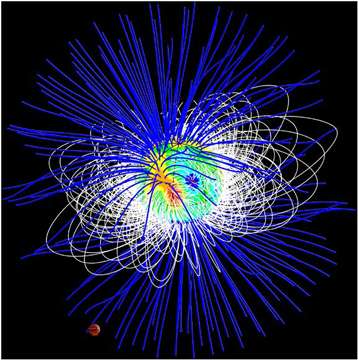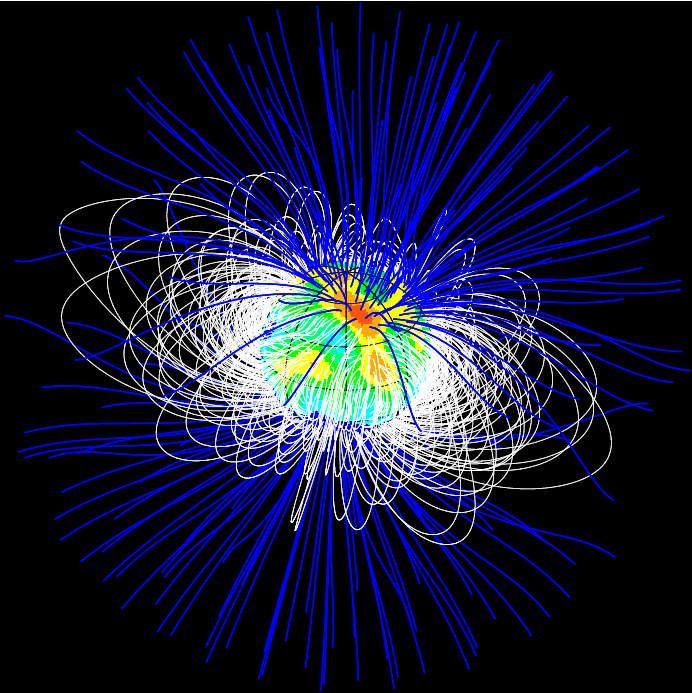Newborn giant planet grazes its star

For the past 20 years, exoplanets known as 'hot Jupiters' have puzzled astronomers. These giant planets orbit 100 times closer to their host stars than Jupiter does to the Sun, which increases their surface temperatures. But how and when in their history did they migrate so close to their star? Now, an international team of astronomers has announced the discovery of a very young hot Jupiter orbiting in the immediate vicinity of a star that is barely two million years old—the stellar equivalent of a week-old infant. This first-ever evidence that hot Jupiters can appear at such an early stage represents a major step forward in our understanding of how planetary systems form and evolve.
The work, led by researchers at the Institut de Recherche en Astrophysique et Planétologie (IRAP, CNRS/Université Toulouse III – Paul Sabatier), in collaboration, amongst others, with colleagues at the Institut de Planétologie et d'Astrophysique de Grenoble (CNRS/Université Grenoble Alpes), is published on 20 June 2016 in the journal Nature.
It was while monitoring a star barely two million years old called V830 Tau, located in the Taurus stellar nursery some 430 light years away, that an international team of astronomers discovered the youngest known hot Jupiter. The team observed the star for a month and a half and detected a regular fluctuation in the star's velocity, revealing the presence of a planet almost as massive as Jupiter, orbiting its host star at a distance only one twentieth of that between the Earth and the Sun. The discovery shows for the first time that hot Jupiters can appear at a very early stage in the formation of planetary systems, and therefore have a major impact on their architecture.
In the Solar System, small rocky planets such as the Earth orbit near the Sun, whereas gas giants like Jupiter and Saturn are found much further out. Astronomers were therefore astonished when the first exoplanets detected turned out to be giants orbiting close to their host star. Theoretical work indicates that such planets can only form in the icy outer regions of the protoplanetary disk in which both the central star and its surrounding planets are born. Some, however, migrate inwards and yet avoid falling into their host star, thus becoming hot Jupiters.

Theoretical models predict that migration occurs either early in the lives of giant planets while still embedded within the protoplanetary disk, or else much later, once multiple planets are formed and interact, flinging some of them into the immediate vicinity of their star. Among the known hot Jupiters, some feature tilted or even backward orbits, suggesting that they were hurled towards their star by neighboring bodies. The discovery of a very young hot Jupiter thus confirms that early migration within the disk also applies to giant planets.
Detecting planets in orbit around very young stars proves to be a significant observational challenge, since such stars are monsters in comparison with our own Sun. This is because their intense magnetic activity interferes with the light emitted by the star to a far greater extent than a potential giant planet, even in a close orbit. One of the team's achievements was to separate the signal caused by the star's activity from the signal produced by the planet.
For this discovery, the team used the twin spectropolarimeters ESPaDOnS and Narval, designed and built at IRAP. ESPaDOnS is mounted on the Canada-France-Hawaii Telescope (CFHT) on the summit of Maunakea, a dormant volcano on the Island of Hawaii. Narval is mounted on the Bernard Lyot telescope (TBL - OMP) atop the Pic du Midi in the French Pyrenees. The combined use of these two telescopes together with Hawaii's Gemini telescope was essential for the required continuous monitoring of V830 Tau. SPIRou and SPIP, the next-generation infrared spectropolarimeters built at IRAP for the CFHT and TBL, scheduled for first light in 2017 and 2019 respectively, will offer vastly superior performance and make it possible to study the formation of new worlds with unprecedented sensitivity.

More information: J. F. Donati et al. A hot Jupiter orbiting a 2-million-year-old solar-mass T Tauri star, Nature (2016). DOI: 10.1038/nature18305
Journal information: Nature
Provided by CNRS



















